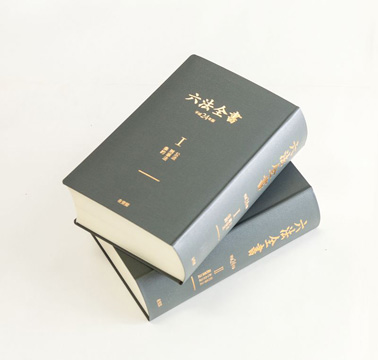Changes in sovereignty and revolution
I have been asked to write about time and the constitution, and so I have chosen to write about revolution. While the common understanding is that Japan has not experienced a revolution, among constitutional scholars there is a valid candidate for this moniker. It is known as the "August Revolution."
If you open the Compendium of Laws to the page on the Constitution of Japan, you will find at the top of the page an imperial edict by the Showa Emperor:
"I rejoice that the foundation for the construction of a new Japan has been laid according to the will of the Japanese people, and hereby sanction and promulgate the amendments of the Imperial Japanese Constitution effected following the consultation with the Privy Council and the decision of the Imperial Diet made in accordance with Article 73 of the said Constitution."
However, positioned below this edict, in the preamble to the Constitution, we find the following phrase: "We, the Japanese people, acting through our duly elected representatives in the National Diet … do proclaim that sovereign power resides with the people and do firmly establish this Constitution." Are these two declarations not incompatible with each other? According to the imperial edict, the Constitution of Japan is created as a result of amendments to the Imperial Japanese Constitution, under which sovereign power was vested in the emperor. It is the same emperor who is promulgating the amended Constitution. However, according to the preamble, sovereign power is vested in the Japanese people, based on whose power the Constitution is established.

Photo: Jun'ichi Kaizuka.
The issue is whether a constitution under which sovereign power resides with the emperor can be amended and a constitution established under which sovereign power is transferred to the people. It does not seem likely. Given that the emperor, as the all-powerful sovereign, has issued an edict to the people, ordering them to decide the political structures of the nation, does that mean that that sovereignty has been handed to the people? If that should be the case, would it be possible for the emperor to change his mind and rescind this order, restoring sovereign power to himself? That is something else that seems unlikely. Sovereignty by the people cannot be explained as being based on the sovereignty of the emperor. Change in sovereignty in itself is revolutionary.
The prevailing view among constitutional law scholars holds that when the Japanese government accepted the Potsdam Declaration unconditionally on August 14, 1945, sovereign power made a revolutionary transition from the emperor to the people. This means that at the point when the new Constitution was promulgated the emperor was no longer vested with sovereign power. Nonetheless, calling it a revolution is simply another way of saying that there is no theoretical explanation for this change. In this way a chasm suddenly opens that defies theoretical explanation, and breaks the temporal continuity of the Constitution.
Changes to constitutional amendment procedures and revolution
If you believe that changes to the Constitution, which cannot be explained theoretically, constitute a revolution, then it becomes clear that such a revolution could occur without a major event such as defeat in war. For example, some people argue that given that the procedures for amending the Constitution of Japan are overly strict, requiring a two-thirds majority of both houses of the Diet before even a proposal can be submitted, amendment cannot be achieved as simply as you may think. This leads to discussion firstly on changing the procedures required for constitutional amendment. However, under certain assumptions, the amendment of the procedures required for constitutional amendment could bring about a revolution that could not be explained in theoretical terms. Let us consider the content of procedures relating to constitutional amendment, as they are stipulated in Article 96 of the Constitution, in this simplified format:
"A: Amendments to this Constitution shall be initiated through procedures P."
By setting forth the contents of "This Constitution" article by article, the stipulation made above could be rewritten in a conjunctive manner, thus: "Amendments to Article 1 of the Constitution shall be initiated through procedures P; and Amendments to Article 2 of the Constitution shall be initiated through procedures P; and Amendments to Article 3…." The semantic meaning of each article is made clear by substituting the text of the article itself. In the example of Article 1, it would be a case of substituting the provision "The Emperor shall be the symbol of the State and of the unity of the people…."
Going through the Constitution in this way, we would eventually arrive at Article 96. As the contents of Article 96 stipulate that "Amendments to this Constitution shall be initiated through procedures P," unless what "This Constitution" refers to is rephrased, (let us assume that) the semantic content of the initial declaration "A" would not be determined. If you attempted to rephrase further the same issue would crop up again upon reaching Article 96, requiring an endless loop of rephrasing and paraphrasing.
In other words, if we assume that the procedures for amending the Constitution that are stipulated in Article 96 also include Article 96 itself, the semantic meaning of Article 96 remains forever unfixed. This is a type of paradox similar to the paradox of Epimenides, a Cretan who once stated that "All Cretans are liars."
If we follow this line of thought through to its conclusion we can see that under the current procedures for amendment it is not possible to amend the stipulation relating to procedures for amendment. Therefore the amendment of procedures for amendment of the Constitution would represent a revolution. Once these procedures were to be changed a vast bottomless chasm would suddenly open and the Constitution would become an entirely different Constitution.
If we look further back in time we see that theologians once discussed the question of whether an almighty god could create a rock so heavy that even god himself could not lift it. If god is incapable of creating such a rock a question arises as to whether that god is truly almighty, but if god does create such a rock and is then unable to lift it, the god is then surely not almighty. The issues surrounding the Constitution, such as if the emperor as the sovereign power can pass on this sovereign power to the people, and whether the Constitution, as the supreme law of the land, is able to control how it is itself changed based on stipulations contained within it, are distant offshoots of such a theological argument.




